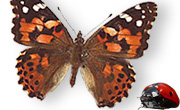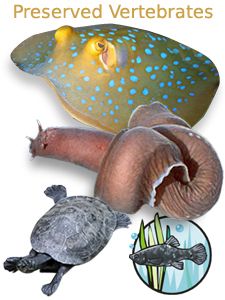Fax: (916) 381-4006



Preserved Vertebrates |
 Vertebrata is a subphylum of chordates, specifically, those with backbones or spinal columns. About 57,739 species of vertebrates have been described. Vertebrates started to evolve about 530 million years ago during the Cambrian explosion, which is part of the Cambrian period (first known vertebrate is Myllokunmingia). Their name derives from the bones of the spinal column (or vertebral column), the vertebrae. Vertebrata is a subphylum of chordates, specifically, those with backbones or spinal columns. About 57,739 species of vertebrates have been described. Vertebrates started to evolve about 530 million years ago during the Cambrian explosion, which is part of the Cambrian period (first known vertebrate is Myllokunmingia). Their name derives from the bones of the spinal column (or vertebral column), the vertebrae.
Vertebrata is the largest subphylum of chordates, and contains most animals with which people are generally familiar (except insects). Fish (including lampreys, but traditionally not hagfish, though this is now disputed), amphibians, reptiles, birds, and mammals (including humans) are vertebrates. Characteristics of the subphylum are a muscular system that mostly consists of paired masses, as well as a central nervous system which is partly located inside the backbone (if one is present). Usually, the defining characteristic of a vertebrate is considered the backbone or spinal cord, a brain case, and an internal skeleton, but the former do not hold true for lampreys, and the latter is arguably present in some other chordates. Rather, all vertebrates are most easily distinguished from all other chordates by having an unequivocal head, that is, sensory organs - especially eyes are concentrated at the fore end of the body and there is pronounced cephalization. Compare the lancelets which have a mouth but no true head, and "see" with their entire back. The internal skeleton which defines vertebrates consists of cartilage or bone, or in some cases both. An outer skeleton in form of a bony armour was the first bony substance the vertebrates evolved. It is possible its primary function was as a phosphate reservoir, excreted as calcium phosphate and stored around the body, offering protection at the same time. The skeleton provides support to the organism during the period of growth. For this reason vertebrates can achieve larger sizes than invertebrates, and on average vertebrates are in fact larger. The skeleton of most vertebrates, that is excluding the most primitive ones, consists of a skull, the vertebral column and two pairs of limbs. In some forms of vertebrates, one or both of these pairs of limbs may be absent, such as in snakes or whales. These limbs have been lost in the course of evolution.
|
| Featured Items |
|---|
| Bullfrogs Plain 5-6-in. -... |
 The American Bull Frog (Rana catesbeiana) is an aquatic frog, a member of the family Ranidae, or "true fr...
The American Bull Frog (Rana catesbeiana) is an aquatic frog, a member of the family Ranidae, or "true fr... |
|
Read more »»»
$11.22 (Buy Now) |
|---|
| Cow Eyes (100+) - Each |
|
Read more »»»
$2.20 (Buy Now) |
|---|
| Fetal Pigs Double Injecte... |
|
Pigs are ungulates native to Eurasia collectively grouped under the genus Sus within the Suidae family. The... |
|
Read more »»»
$21.45 (Buy Now) |
|---|
| Lamprey Plain - Each |

A lamprey is a jawless fish with a toothed, funnel-like sucking mouth, with which most species bore into th... |
|
Read more »»»
$16.14 (Buy Now) |
|---|
| Perch Plain 9-11-in. - Ea... |

Perca is the genus of fish referred to as perch or yellow perch, a group of freshwater fish belonging to th... |
|
Read more »»»
$4.70 (Buy Now) |
|---|
| Pigeons Plain - Each |

The doves are the 308 species of near passerine birds in the order Columbiformes. The terms dove an... |
|
Read more »»»
$12.90 (Buy Now) |
|---|
| Shark Double Injected 27+... |

Sharks are a group (superorder Selachimorpha) of fish, with a full cartilaginous skeleton and a streamlined... |
|
Read more »»»
$19.80 (Buy Now) |
|---|
| Sheep Pluck (10+) - Each |
|
Read more »»»
$16.00 (Buy Now) |
|---|
9298 Elder Creek Road
Sacramento, CA 95829
(916) 386-2665
9298 Elder Creek Road
Sacramento, CA 95829
(916) 386-2665